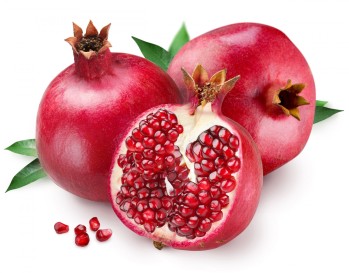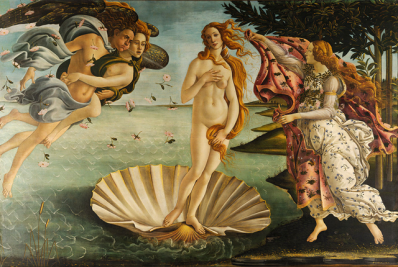By Patricia Paquette
January 2017
If Mother Nature hadn’t bestowed a tiny crown on pomegranates, her human subjects might certainly have placed one there by now. These jeweled fruits have delighted our ancestors at the table and in the arts for millennia. And if anything, their popularity has reached an all-time high in the modern world.

None of that made any difference to us when we were youngsters and transplants from New England to Southern California. My brother, sisters and I barely noticed the pomegranate tree that sometimes scratched our bare arms when we raced in and out of the kitchen door. However, all that changed during our first autumn, when we peeled open the baseball-sized fruits and turned ourselves into vampires, crimson juice running down our faces and arms and staining the concrete patio. To this day, we still agree that no other fruit – apple, banana or pear – is so mysterious and so much fun to eat.
Only recently did I learn that other children, in other cultures, grow up enjoying pomegranates in a much more elegant way. My eyes were opened by a former colleague, a distinguished television journalist, who wrote to tell me how he had learned to eat pomegranates from members of his Middle Eastern family. They left Iran when he was 4 years old, and he went back to visit during the summer of his freshman year in college. Throughout his childhood, many of his relatives came to see his family here, he said . . .
“. . .So my memories are from those moments with family, and this is how I recall it. To start, we would not cut the pomegranate open. Instead, first we warmed the fruit by cradling it in our hands . . .”
He had learned an age-old custom of sharing and honoring this legendary fruit, which has been in cultivation throughout most of human history. The pomegranate tree is native to the Middle East from Iran to the Himalayas in northern India, and thrives today in semi-arid, mild-temperate climates throughout the world.
Its family tree is ripe with mythology and symbolism evoking love, luck and long life. The fruit is one of the sacred symbols of Aphrodite, goddess of love – you may also know her as the Roman goddess Venus, the one pictured rising from a seashell, long, golden-red hair flowing. In ancient Roman times, women wore headdresses made of pomegranate twigs to signify their availability for marriage.
Some customs still prevail. In Crete, when a bride enters her new home, the groom hands her a pomegranate. In Turkey, the bride throws a pomegranate to the ground after the marriage ceremony in the belief that the number of seeds that spill out indicates the number of children she will bear.
Indeed, it seems that artists, writers and storytellers have enjoyed pomegranates as much as we do. In Greek mythology, the six pomegranate seeds that Hades tricked the goddess Persephone into eating account for our alternate seasons of growth and fallow on the earth. Centuries later, in another story, Juliet tries to convince Romeo to stay a while longer, since it’s still early enough that they can hear the nightingale, who “nightly sings in yon pomegranate tree.” The fruit is pictured in works from ancient times to those by Renaissance artists such as Botticelli and da Vinci, either being held in hand, ripe with promise, or having burst open to display its seeds – which are technically called “arils.”
These images became entwined with my colleague’s story, and as he continued, I could almost hear his dramatic “news” voice narrating the words on my computer screen . . .
“. . . When the pomegranate is warm, we squeeze it between our two hands until we can hear the seeds inside start to make a crunching sound. Then, we pass the fruit to a friend or to another member of the family, who takes a turn at squeezing firmly – but not too firmly, because you don’t want to break the skin. There’s an art to this.”
Yes, art and time. The noble pomegranate has been traced to the 3rd millennium B.C.E. through fossil records, stories and images. It was eaten, used in medical treatments and when dried and powdered, its red-leather skin was the source of dye for carpets. The “father of medicine,” Hippocrates, used pomegranate to soothe problems from digestion to skin inflammation.
Among other evidence of its value to human life and culture, a Purdue University research paper points out that pomegranates were “featured in Egyptian mythology and art, praised in the Old Testament of the Bible and in the Babylonian Talmud, and carried by desert caravans for the sake of their thirst-quenching juice.”
This long history is echoed in my friend’s story about eating pomegranates with his family:
“When we don’t hear or feel any more crunching sounds, the pomegranate is ready to be bitten into and enjoyed. Just a small bite, so you can start drinking the juice, and then, using your two hands, squeeze it even more, passing it back and forth.”
Even this fruit’s name is packed with juicy history. An essay in HortScience explains that pomegranates are known as Punica granatum in the horticultural world, so named by the eminent botanist Carl Linnaeus: Punica is a variation on the Roman name for Carthage, the ancient city in northern Tunisia from which the best pomegranates came to Italy. In Medieval Latin, “pome” is apple or fruit, and granatum means seedy or grainy. Interestingly, since “pomme” is French for “apple,” its name in the United States literally means “seedy apple.” However, the French are said to call the fruit, “grenade,” because of its similarities in appearance to the military weapon.
By 2000 B.C.E., Phoenicians had established Mediterranean Sea colonies in North Africa, bringing pomegranates to modern-day Tunisia and Egypt. As traced in HortScience, the fruit’s journey continued around the globe and by 800 C.E., pomegranates were known across the Roman Empire, including Spain, whose explorers and settlers introduced it into the Americas.
The trees were grown in Spanish Florida and English Georgia in the early 1700s, were planted at Monticello by the intrepid red-headed “founding gardener” Thomas Jefferson in the 1770s, and had made their way across the continent to the Spanish mission orchards in California at about the same time. California Rare Fruit Growers have traced ‘Wonderful,’ the most commonly grown cultivated variety in the United States, to its discovery in Florida and cultivation in California by 1896.

Can you grow your own? Yes, if you live in areas of the desert Southwest United States. Gardeners in the Southeast should look for one of the humidity-tolerant selections developed for this region. Pomegranates require high summer temperatures to produce fruit successfully. In other regions, gardeners value the shrubby trees as landscape plants, where they are especially useful as hedges, with glossy leaves and showy orange-red flowers beloved by hummingbirds. However, those flowers are usually not going to develop into the familiar large fruits. Information on your state’s Cooperative Extension website can help you choose recommended cultivated varieties for your garden or orchard.
Even in very cold climates, dwarf cultivars will do well in in outdoor containers when they are treated like tender perennials and protected from frost; look for the name ‘Nana’ in the description on the plant tag. Because Nana’s flowers and fruits are miniatures of those on the standard-sized plants, these little trees are treasured subjects for bonsai artists.
While the pomegranate’s story is woven into the rich tapestry of art and culture in many countries of the Old World, the widely proclaimed health benefits of its high level of antioxidants are earning it a place in the New World. And then there are the recipes, some thousands of years old and some on menus in 5-star restaurants, from cocktails – pomegranate juice is the basis of grenadine syrup, after all – to desserts such as pomegranate panna cotta.
With prepared juice, syrup and seeds available in most grocery stores, it’s easy to venture beyond the gorgeous sprinkles we see on so many salads, and try a salad dressing, such as this vinaigrette:
Pomegranate-Honey Vinaigrette
1 cup POM Wonderful pomegranate juice
4 T red wine vinegar
4 T honey
4 tsp Dijon mustard
4 tsp chopped fresh thyme (or ½ teaspoon dried)
1 tsp fresh tarragon (or ½ teaspoon dried)
Mix these ingredients in a blender or shake them in an air-tight container until well-blended. Serve with salad greens or over a salad of roasted vegetables and cooked grains such as quinoa, rice or lentils. If you explore, you’ll find similar salad dressing recipes made with olive oil or pomegranate “molasses” syrup.
And now that his story about sharing a pomegranate was drawing to a close, my friend described a memorable, mouth-watering ending . . .
“. . . And at some point, and hopefully not too early, the skin will break open even more and you can cut the pomegranate open and enjoy the seeds that haven’t broken. There’s really nothing like the taste, and nothing like this experience.”
I cannot wait to try this with an adventurous friend. Just to be on the safe side, we’ll probably try it outdoors, on the patio. With prosecco.

Delighted with this piece, outstanding research, remarkable tidbits (not to be confused with alternate facts). Turkey would overrun the world if women had as many babies as pomegranate seeds! Wish I could join you on your patio for that pomegranate feast – I recommend Prosecco as the go-with….
LikeLike
Tears of joy as I catch up with you on the phone and simultaneously browse your blog for the first time…
LikeLike